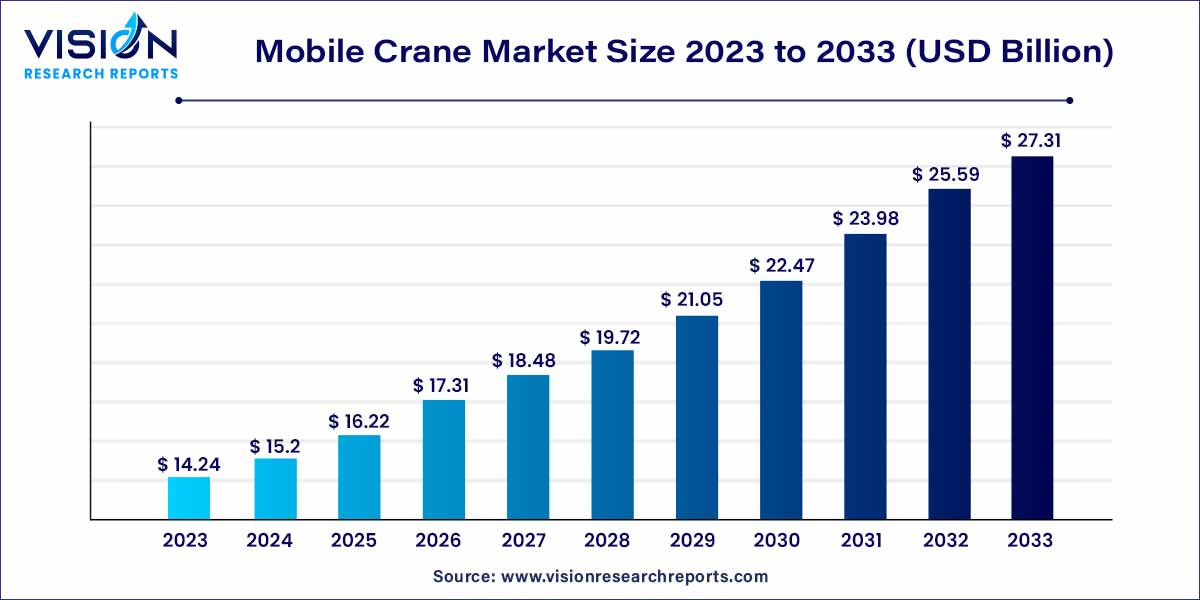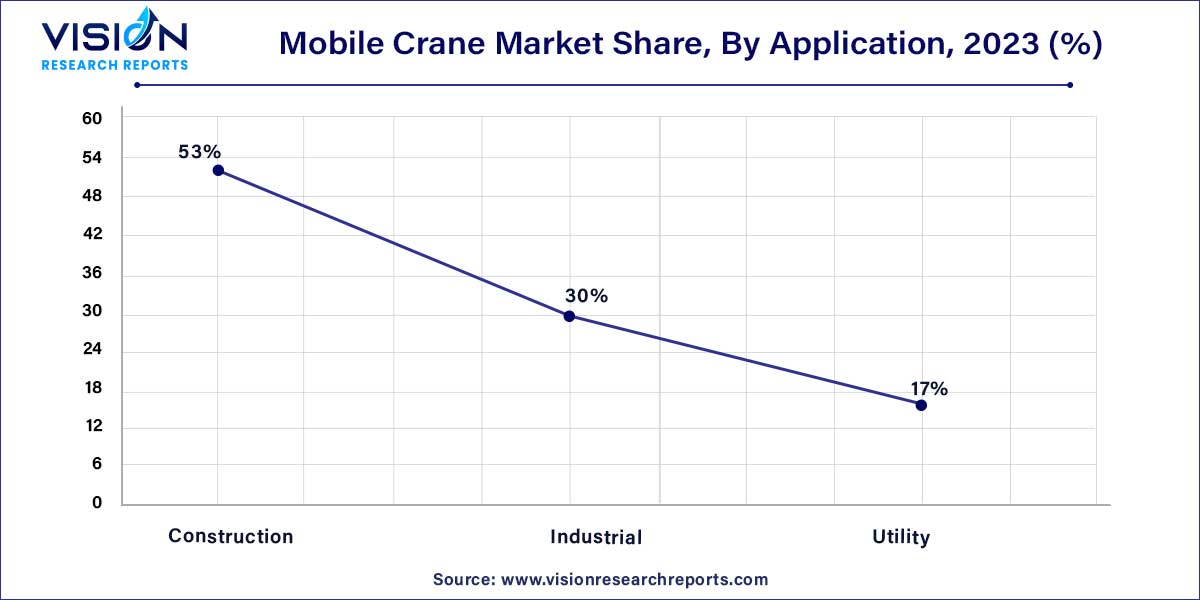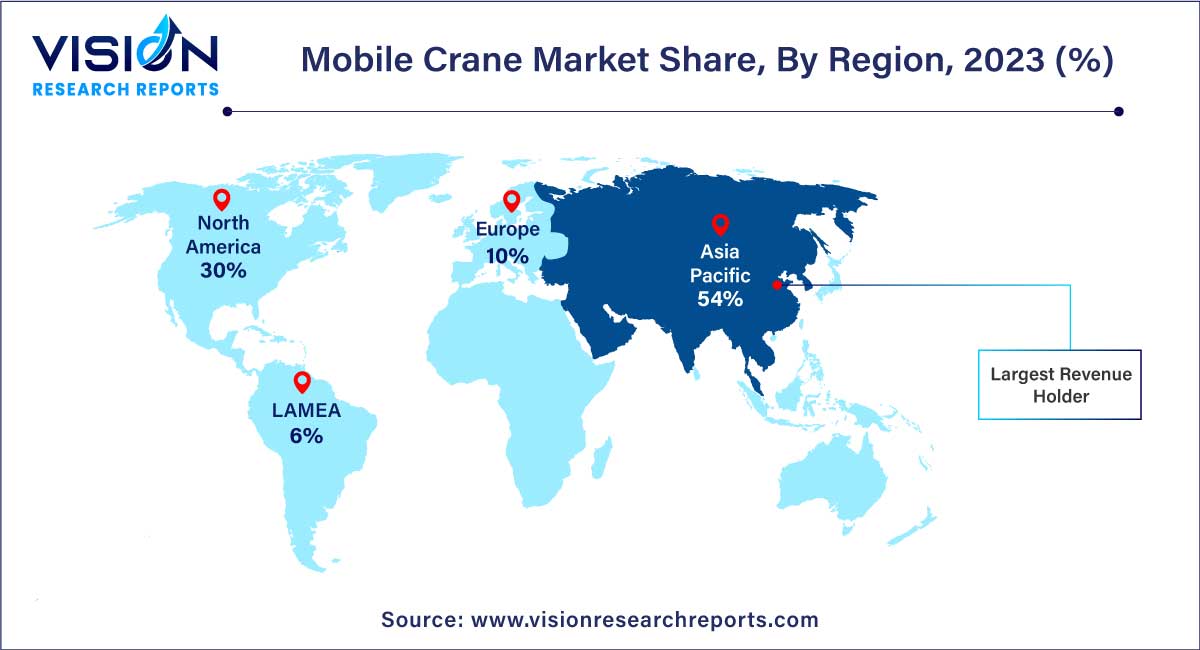The global mobile crane market size was estimated at around USD 14.24 billion in 2023 and it is projected to hit around USD 27.31 billion by 2033, growing at a CAGR of 6.73% from 2024 to 2033.

The mobile crane market stands as a dynamic sector within the heavy machinery industry, characterized by continuous innovation and a crucial role in diverse applications. This overview delves into the key facets of the mobile crane market, offering insights into its current state, growth drivers, challenges, and future prospects.
The mobile crane market is poised for robust growth, fueled by several key factors. Firstly, the ongoing surge in global construction activities, driven by urbanization and infrastructure development, continues to escalate the demand for mobile cranes. Their versatility and ability to navigate diverse job sites make them indispensable assets in various industries. Technological advancements, including the integration of telematics and automation, further enhance their efficiency and safety features, attracting increased adoption. Additionally, the market benefits from a continual focus on innovation by manufacturers, leading to the development of high-performance, cutting-edge crane solutions. As emerging economies ramp up their construction efforts and mature markets undergo replacement cycles, the overall demand for mobile cranes is expected to sustain an upward trajectory, positioning the market for substantial growth in the foreseeable future.
| Report Coverage | Details |
| Market Revenue by 2033 | USD 27.31 billion |
| Growth Rate from 2024 to 2033 | CAGR of 6.73% |
| Revenue Share of Asia Pacific in 2023 | 54% |
| Base Year | 2023 |
| Forecast Period | 2024 to 2033 |
| Market Analysis (Terms Used) | Value (US$ Million/Billion) or (Volume/Units) |
The truck-mounted crane segment accounted for the largest revenue share of 64% in 2023. The rising demand for mobile machinery in power and utilities, construction, and other industries and verticals is expected to boost the growth of the segment. Truck-mounted equipment offers a high loading capacity and can help in transporting goods easily from one place to another. These products are typically used in construction projects, such as bridge construction, railway projects, and hydropower projects.
The crawler crane segment is expected to grow at the fastest CAGR of 7.65% during the forecast period. Crawler cranes are compact and offer the ease of accessibility required in small construction sites, especially in urban areas. Crawler cranes are considered the most powerful cranes for use in different projects involving heavy industrial materials and other large-scale construction activities. Nevertheless, crawler cranes and trailer-mounted cranes accounted for a smaller share of the market as compared to truck-mounted cranes, owing to their limited operational capabilities.
The construction segment held the largest revenue share of 53% in 2023 in the mobile cranes market. Continued residential and commercial infrastructure projects across the globe are expected to support the growth of the segment. Tower cranes, once installed, can only be moved once the project is completed. Hence, builders working on numerous projects usually prefer mobile cranes as they are easy to move. Deployment of mobile cranes can also reduce the idle time of the equipment and subsequently enhance productivity.

The utility segment is expected to expand at the fastest CAGR of 7.37% over the forecast period. The growth of the segment can be attributed to the extensive use of mobile cranes in oil & gas projects, power projects, and utility projects, among others involving critical applications, such as underground construction. Utility companies require these types of equipment at construction sites as well as in their respective yards.
Asia Pacific region dominated the market with the largest market share of 54% in 2023 and is expected to expand at the fastest CAGR during the forecast period, owing to the rapid pace of construction activities in emerging economies such as China, India, and the Philippines. The Indian government's "Bharatmala Pariyojana" infrastructure development scheme envisages improvements in the country’s road network. The Asian Infrastructure Investment Bank (AIIB) already invested USD 200 million in the National Investment & Infrastructure Fund (NIIF) in 2018 to contribute to India's infrastructure development.
The promising expansion of the infrastructure development and manufacturing sectors is driving the adoption of mobile cranes in China. Favorable government initiatives, such as the Belt and Road Initiative (BRI), are expected to lead to aggressive investments in new development projects. As of January 2021, around 140 countries have joined the BRI by signing a Memorandum of Understanding (MoU) with China. The list of BRI countries varies from economically underprivileged to financially stronger countries.

For underprivileged countries, the BRI is a foundation of development funds for infrastructural aspects such as highways, bridges, and ports, as well as an access route to markets in China and other countries to be connected by the BRI. It also allows such countries to reduce their dependency on financial and infrastructure support from developed countries and, in turn, allows the domestic Chinese mobile crane manufacturers to foray into these untapped markets.
The MEA is projected to register significant growth over the forecast period. The growth can be attributed to the increasing investment in residential and commercial infrastructure projects in the region. East African countries such as Kenya, Ethiopia, and Rwanda are investing aggressively in infrastructure development. For instance, in 2018, the Kenyan government announced 'the Big Four,' an ambitious infrastructure development project aimed at encouraging manufacturing, providing affordable housing and healthcare facilities, and ensuring food security.
By Product Type
By Application
By Region
Chapter 1. Introduction
1.1. Research Objective
1.2. Scope of the Study
1.3. Definition
Chapter 2. Research Methodology
2.1. Research Approach
2.2. Data Sources
2.3. Assumptions & Limitations
Chapter 3. Executive Summary
3.1. Market Snapshot
Chapter 4. Market Variables and Scope
4.1. Introduction
4.2. Market Classification and Scope
4.3. Industry Value Chain Analysis
4.3.1. Raw Material Procurement Analysis
4.3.2. Sales and Distribution Channel Analysis
4.3.3. Downstream Buyer Analysis
Chapter 5. COVID 19 Impact on Mobile Crane Market
5.1. COVID-19 Landscape: Mobile Crane Industry Impact
5.2. COVID 19 - Impact Assessment for the Industry
5.3. COVID 19 Impact: Global Major Government Policy
5.4. Market Trends and Opportunities in the COVID-19 Landscape
Chapter 6. Market Dynamics Analysis and Trends
6.1. Market Dynamics
6.1.1. Market Drivers
6.1.2. Market Restraints
6.1.3. Market Opportunities
6.2. Porter’s Five Forces Analysis
6.2.1. Bargaining power of suppliers
6.2.2. Bargaining power of buyers
6.2.3. Threat of substitute
6.2.4. Threat of new entrants
6.2.5. Degree of competition
Chapter 7. Competitive Landscape
7.1.1. Company Market Share/Positioning Analysis
7.1.2. Key Strategies Adopted by Players
7.1.3. Vendor Landscape
7.1.3.1. List of Suppliers
7.1.3.2. List of Buyers
Chapter 8. Global Mobile Crane Market, By Product Type
8.1. Mobile Crane Market, by Product Type, 2024-2033
8.1.1. Truck Mounted Crane
8.1.1.1. Market Revenue and Forecast (2021-2033)
8.1.2. Trailer Mounted Crane
8.1.2.1. Market Revenue and Forecast (2021-2033)
8.1.3. Crawler Crane
8.1.3.1. Market Revenue and Forecast (2021-2033)
Chapter 9. Global Mobile Crane Market, By Application
9.1. Mobile Crane Market, by Application, 2024-2033
9.1.1. Construction
9.1.1.1. Market Revenue and Forecast (2021-2033)
9.1.2. Industrial
9.1.2.1. Market Revenue and Forecast (2021-2033)
9.1.3. Utility
9.1.3.1. Market Revenue and Forecast (2021-2033)
Chapter 10. Global Mobile Crane Market, Regional Estimates and Trend Forecast
10.1. North America
10.1.1. Market Revenue and Forecast, by Product Type (2021-2033)
10.1.2. Market Revenue and Forecast, by Application (2021-2033)
10.1.3. U.S.
10.1.3.1. Market Revenue and Forecast, by Product Type (2021-2033)
10.1.3.2. Market Revenue and Forecast, by Application (2021-2033)
10.1.4. Rest of North America
10.1.4.1. Market Revenue and Forecast, by Product Type (2021-2033)
10.1.4.2. Market Revenue and Forecast, by Application (2021-2033)
10.2. Europe
10.2.1. Market Revenue and Forecast, by Product Type (2021-2033)
10.2.2. Market Revenue and Forecast, by Application (2021-2033)
10.2.3. UK
10.2.3.1. Market Revenue and Forecast, by Product Type (2021-2033)
10.2.3.2. Market Revenue and Forecast, by Application (2021-2033)
10.2.4. Germany
10.2.4.1. Market Revenue and Forecast, by Product Type (2021-2033)
10.2.4.2. Market Revenue and Forecast, by Application (2021-2033)
10.2.5. France
10.2.5.1. Market Revenue and Forecast, by Product Type (2021-2033)
10.2.5.2. Market Revenue and Forecast, by Application (2021-2033)
10.2.6. Rest of Europe
10.2.6.1. Market Revenue and Forecast, by Product Type (2021-2033)
10.2.6.2. Market Revenue and Forecast, by Application (2021-2033)
10.3. APAC
10.3.1. Market Revenue and Forecast, by Product Type (2021-2033)
10.3.2. Market Revenue and Forecast, by Application (2021-2033)
10.3.3. India
10.3.3.1. Market Revenue and Forecast, by Product Type (2021-2033)
10.3.3.2. Market Revenue and Forecast, by Application (2021-2033)
10.3.4. China
10.3.4.1. Market Revenue and Forecast, by Product Type (2021-2033)
10.3.4.2. Market Revenue and Forecast, by Application (2021-2033)
10.3.5. Japan
10.3.5.1. Market Revenue and Forecast, by Product Type (2021-2033)
10.3.5.2. Market Revenue and Forecast, by Application (2021-2033)
10.3.6. Rest of APAC
10.3.6.1. Market Revenue and Forecast, by Product Type (2021-2033)
10.3.6.2. Market Revenue and Forecast, by Application (2021-2033)
10.4. MEA
10.4.1. Market Revenue and Forecast, by Product Type (2021-2033)
10.4.2. Market Revenue and Forecast, by Application (2021-2033)
10.4.3. GCC
10.4.3.1. Market Revenue and Forecast, by Product Type (2021-2033)
10.4.3.2. Market Revenue and Forecast, by Application (2021-2033)
10.4.4. North Africa
10.4.4.1. Market Revenue and Forecast, by Product Type (2021-2033)
10.4.4.2. Market Revenue and Forecast, by Application (2021-2033)
10.4.5. South Africa
10.4.5.1. Market Revenue and Forecast, by Product Type (2021-2033)
10.4.5.2. Market Revenue and Forecast, by Application (2021-2033)
10.4.6. Rest of MEA
10.4.6.1. Market Revenue and Forecast, by Product Type (2021-2033)
10.4.6.2. Market Revenue and Forecast, by Application (2021-2033)
10.5. Latin America
10.5.1. Market Revenue and Forecast, by Product Type (2021-2033)
10.5.2. Market Revenue and Forecast, by Application (2021-2033)
10.5.3. Brazil
10.5.3.1. Market Revenue and Forecast, by Product Type (2021-2033)
10.5.3.2. Market Revenue and Forecast, by Application (2021-2033)
10.5.4. Rest of LATAM
10.5.4.1. Market Revenue and Forecast, by Product Type (2021-2033)
10.5.4.2. Market Revenue and Forecast, by Application (2021-2033)
Chapter 11. Company Profiles
11.1. Bauer AG
11.1.1. Company Overview
11.1.2. Product Offerings
11.1.3. Financial Performance
11.1.4. Recent Initiatives
11.2. KATO WORKS CO., LTD.
11.2.1. Company Overview
11.2.2. Product Offerings
11.2.3. Financial Performance
11.2.4. Recent Initiatives
11.3. KOBELCO Construction Machinery Co., Ltd.
11.3.1. Company Overview
11.3.2. Product Offerings
11.3.3. Financial Performance
11.3.4. Recent Initiatives
11.4. Liebherr-International AG
11.4.1. Company Overview
11.4.2. Product Offerings
11.4.3. Financial Performance
11.4.4. LTE Scientific
11.5. LiuGong Machinery Co., Ltd.
11.5.1. Company Overview
11.5.2. Product Offerings
11.5.3. Financial Performance
11.5.4. Recent Initiatives
11.6. Manitex International
11.6.1. Company Overview
11.6.2. Product Offerings
11.6.3. Financial Performance
11.6.4. Recent Initiatives
11.7. PALFINGER AG
11.7.1. Company Overview
11.7.2. Product Offerings
11.7.3. Financial Performance
11.7.4. Recent Initiatives
11.8. SANY HEAVY INDUSTRY INDIA PRIVATE LIMITED
11.8.1. Company Overview
11.8.2. Product Offerings
11.8.3. Financial Performance
11.8.4. Recent Initiatives
11.9. Sarens NV
11.9.1. Company Overview
11.9.2. Product Offerings
11.9.3. Financial Performance
11.9.4. Recent Initiatives
11.10. Sumitomo Heavy Industries, Ltd.
11.10.1. Company Overview
11.10.2. Product Offerings
11.10.3. Financial Performance
11.10.4. Recent Initiatives
Chapter 12. Research Methodology
12.1. Primary Research
12.2. Secondary Research
12.3. Assumptions
Chapter 13. Appendix
13.1. About Us
13.2. Glossary of Terms
 Cross-segment Market Size and Analysis for
Mentioned Segments
Cross-segment Market Size and Analysis for
Mentioned Segments
 Additional Company Profiles (Upto 5 With No Cost)
Additional Company Profiles (Upto 5 With No Cost)
 Additional Countries (Apart From Mentioned Countries)
Additional Countries (Apart From Mentioned Countries)
 Country/Region-specific Report
Country/Region-specific Report
 Go To Market Strategy
Go To Market Strategy
 Region Specific Market Dynamics
Region Specific Market Dynamics Region Level Market Share
Region Level Market Share Import Export Analysis
Import Export Analysis Production Analysis
Production Analysis Others
Others